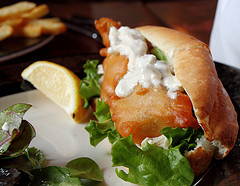DNA Tests Show Cheaper Fish "Mislabled" As Pricier Kinds At Restaurants
In an investigation, the Boston Globe gathered fish from 134 restaurants, supermarkets and fish-mongers. They hired an independent lab to test the fish for authenticity and discovered 87 of the 183 fish tested were “mislabeled,” a whopping 48%.
The Boston Globe found escolar being sold as white tuna, and the Alaskan butterfish being sold at a celebrity restaurant was sablefish, both much cheaper. $23 flounder was actually swai, sold for $4 a pound. It’s a kind of Vietnamese catfish. Another common trick the paper found was for restaurants to put cod on the menu and serve up haddock.
Escolar is banned in Japan because it can sometimes make people sick. It’s also referred to as “ex lax” fish because of its effects on the digestive system.
Sometimes it’s error, “mislabeling,” or outright fraud.
“Mislabeling fish is at a ridiculous level,” Eric Hesse, a Cape Cod commercial fisherman told the Boston Globe. “The dealers and restaurants have a vested interest in keeping the illusion going. Every time they can say they are selling fresh local fish and get away with selling [Pacific] frozen, they don’t have to buy from us. It kills us.”
Regulation is lax, enforcement is hard, and a lot of fish just looks the same after it’s been cooked, turned into a fillet, or fried up.
“A lot of people do it until they get caught,” a seafood wholesaler told The Boston Globe. “We don’t play the game. But too many people do. And the average consumer just doesn’t know.”
On the menu, but not on your plate [The Boston Globe] (Thanks to ABM!)
Want more consumer news? Visit our parent organization, Consumer Reports, for the latest on scams, recalls, and other consumer issues.


